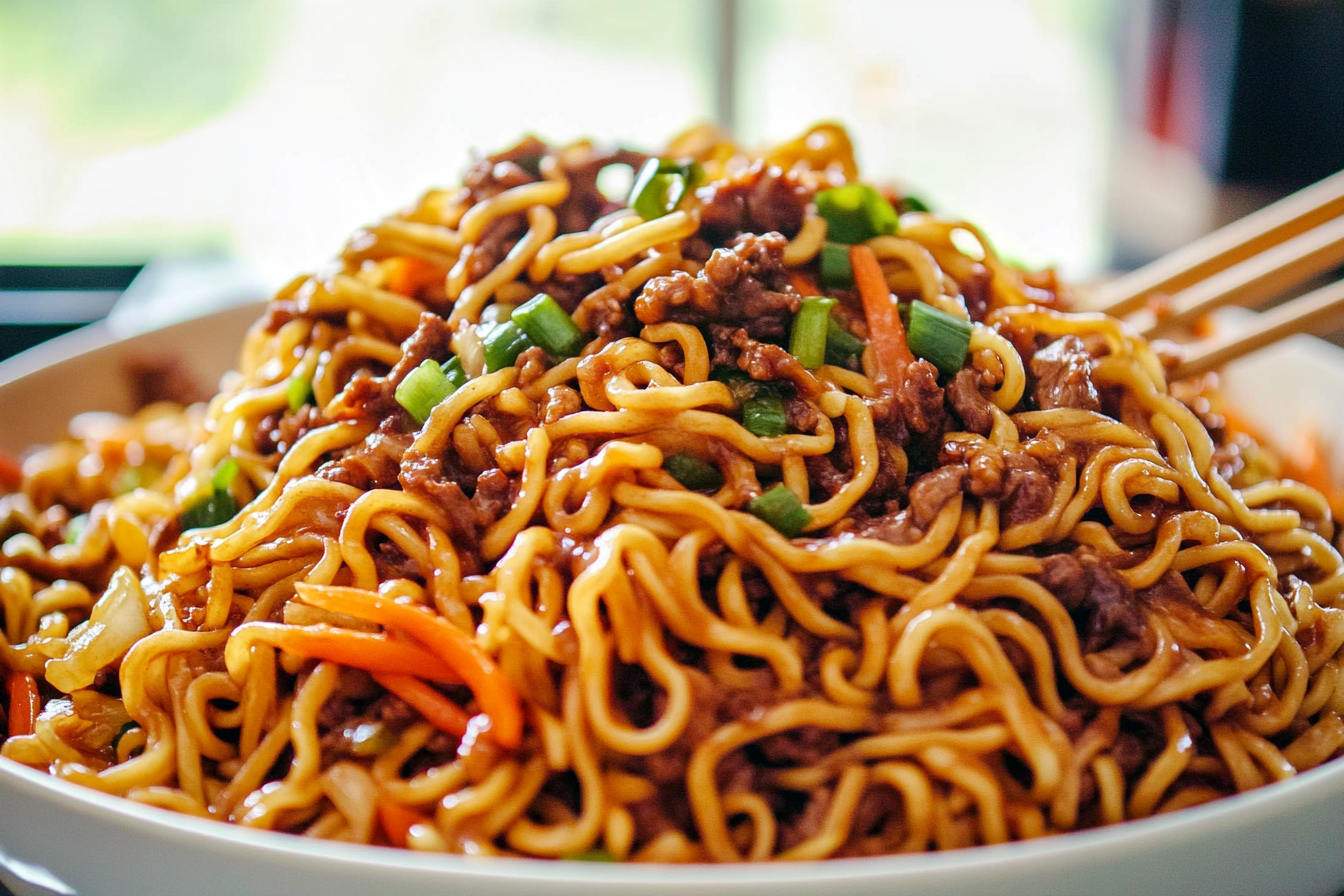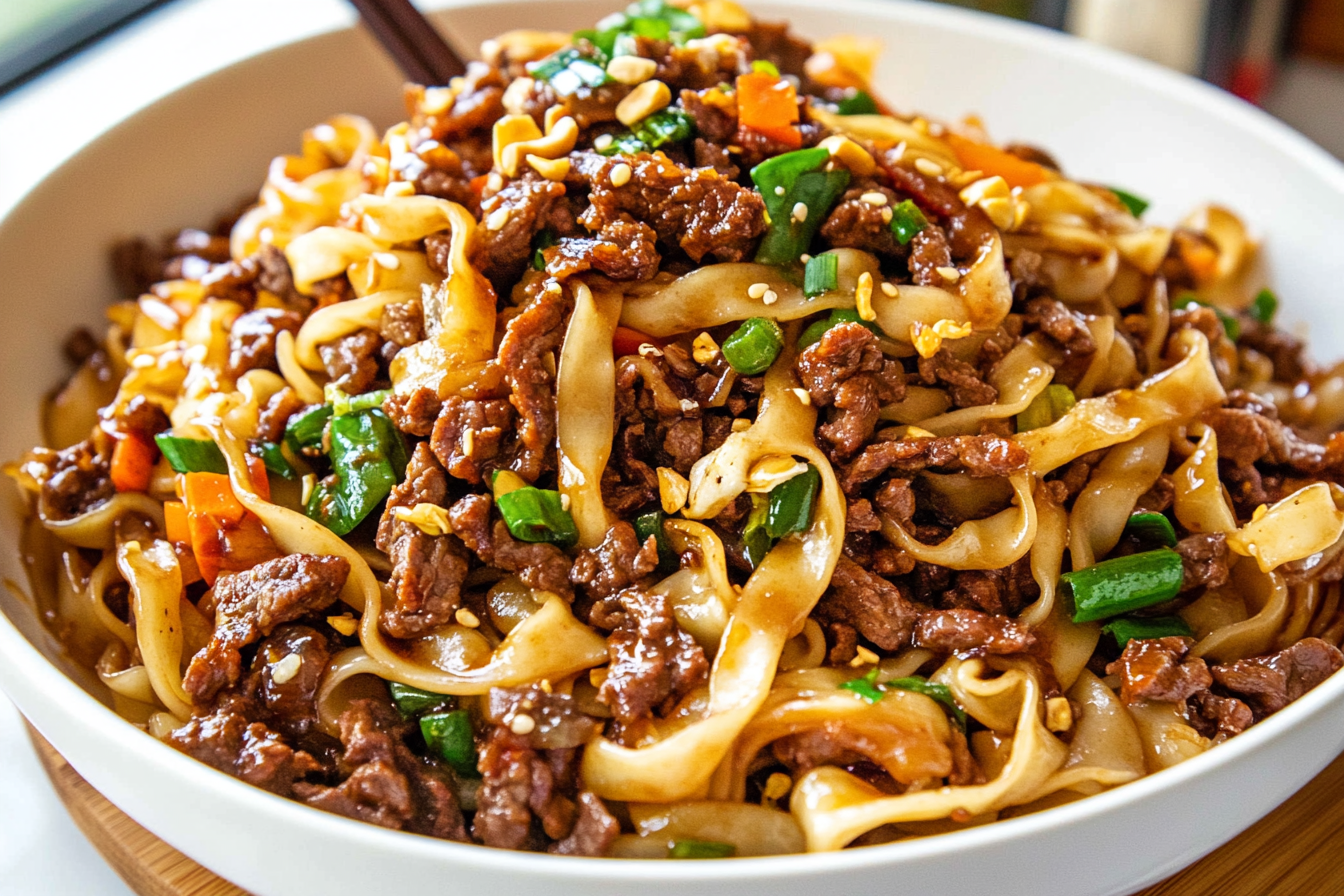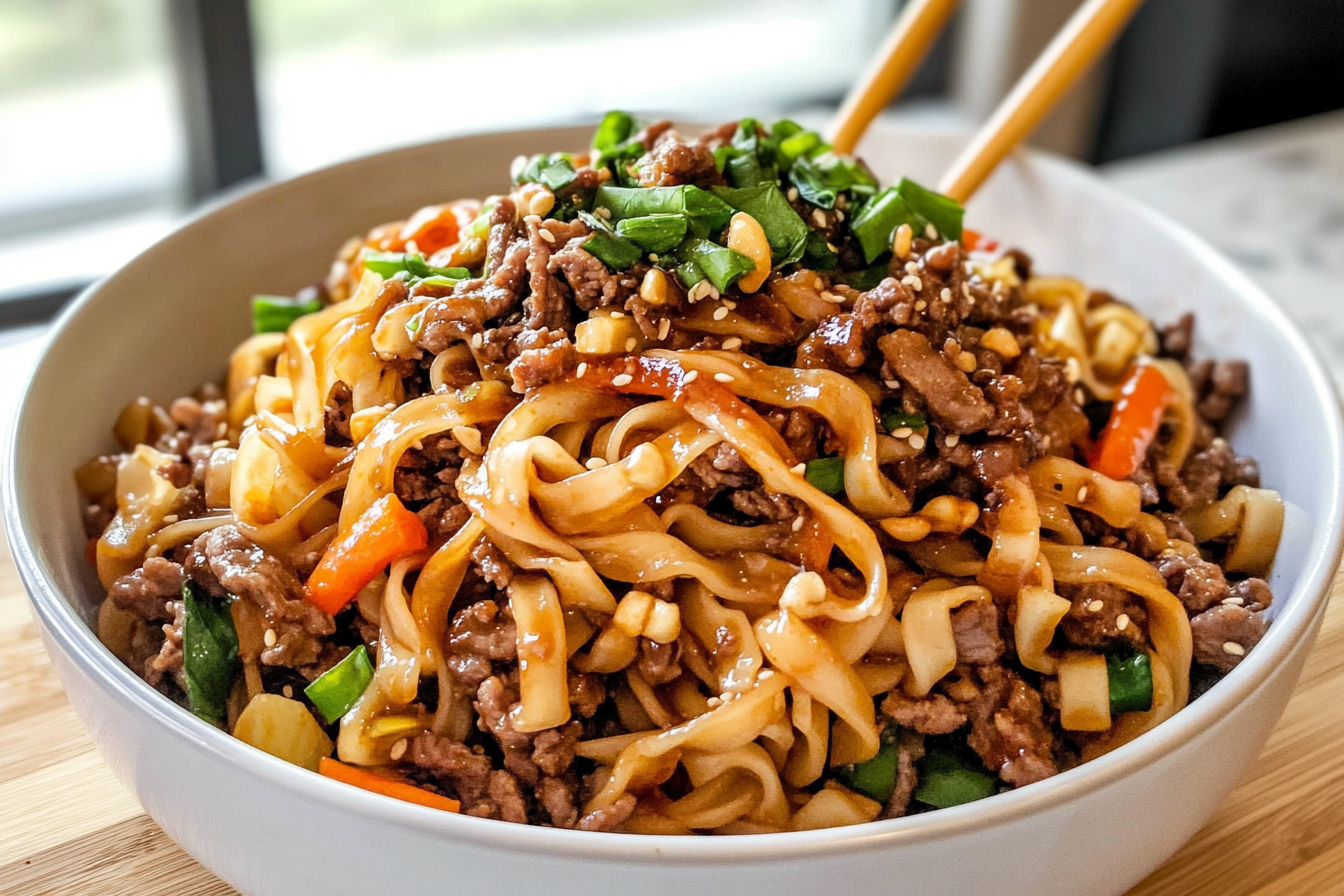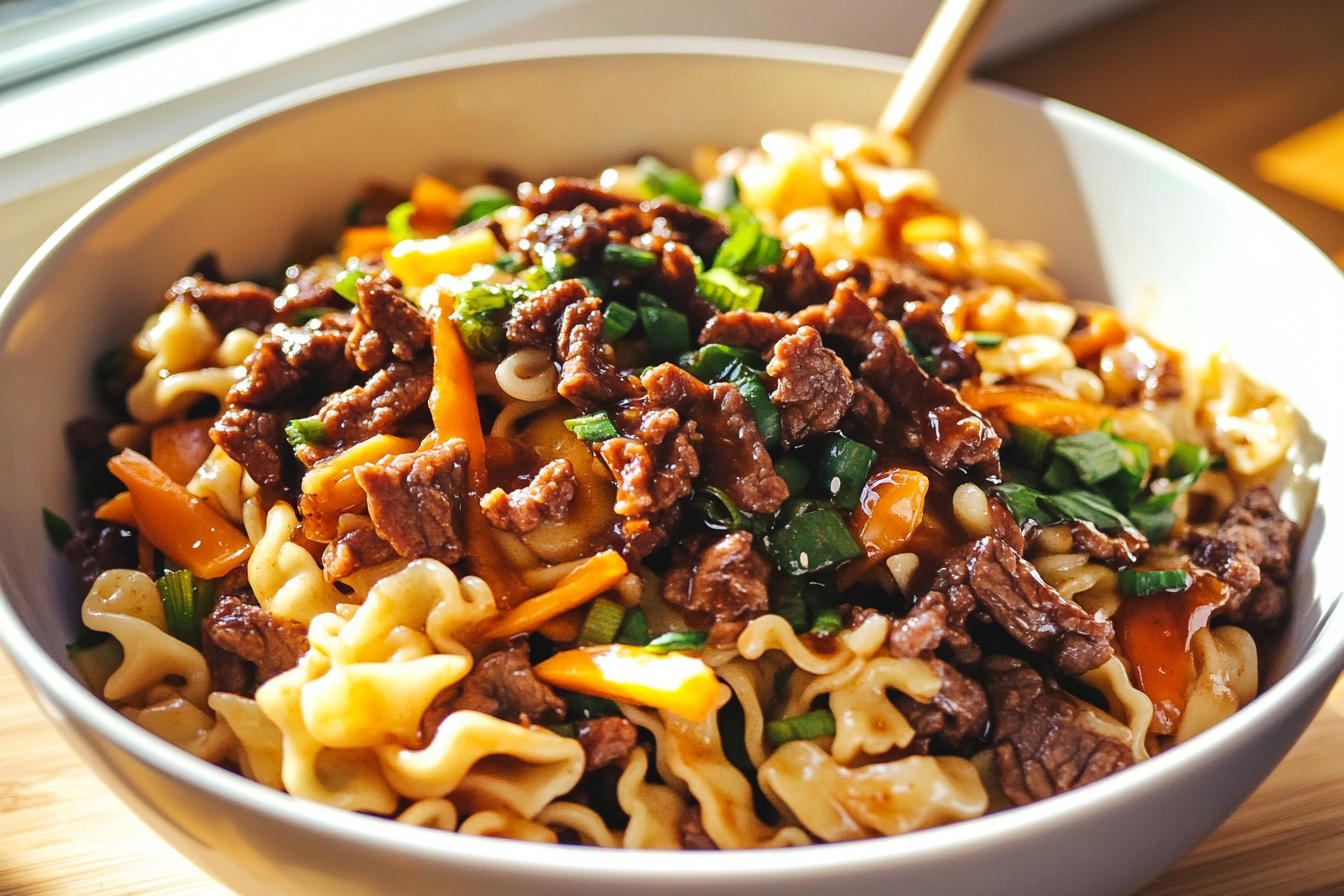Introduction to Hoisin Beef Noodles Recipe
In the vibrant tapestry of Asian cuisine, Hoisin Beef Noodles emerges as a delightful fusion of rich flavors and comforting textures. This dish, deeply rooted in Chinese culinary traditions, showcases the versatile and much-loved hoisin sauce—a condiment that dates back to ancient China. Originally used in various regional recipes as a seasoning and glaze for meats, hoisin sauce brings an enticing blend of sweet, savory, and umami notes that elevate any dish to new heights, particularly when paired with beef and noodles.
Hoisin Beef Noodles is more than just a meal; it’s a sensory journey that captivates with every bite. Picture succulent strips of beef tenderly sautéed to perfection, mingling with chewy, perfectly-cooked noodles, all cloaked in the luscious embrace of hoisin sauce. The aroma alone evokes images of bustling markets and family gatherings around vibrant tables laden with aromatic dishes.
This recipe is a wonderful choice for home cooking, providing both a satisfying meal and an opportunity to explore a beloved piece of culinary heritage. Its ingredients are simple and accessible, yet they come together in a harmonious symphony of taste that transforms an ordinary dinner into an extraordinary experience. Whether you’re a novice in the kitchen or a seasoned home chef, the Hoisin Beef Noodles recipe offers ease of preparation and a depth of flavor that promises to satisfy your craving for both comfort and adventure.
Embrace the culinary artistry of Hoisin Beef Noodles and allow its rich history and delicious taste to transport your cooking from the everyday to the exceptional. With each serving, you’re not just feeding your appetite but connecting with a tradition that transcends time and geography, making it a truly enriching dining experience for you and your loved ones.

“`html
Ingredients for Hoisin Beef Noodles Recipe
- 200g beef sirloin, thinly sliced
- 200g dried egg noodles
- 3 tablespoons hoisin sauce
- 2 tablespoons soy sauce
- 1 tablespoon oyster sauce
- 1 tablespoon vegetable oil
- 1 medium onion, thinly sliced
- 2 cloves garlic, minced
- 1 tablespoon grated ginger
- 1 red bell pepper, thinly sliced
- 100g snow peas, trimmed
- 1 tablespoon sesame oil
- 1 teaspoon sesame seeds, for garnish
- 2 green onions, sliced, for garnish
- Optional: 1 tablespoon sriracha or chili paste for added spice
- Optional: 1 tablespoon peanut butter for a nutty flavor
- Optional substitution: Use gluten-free soy sauce to make the dish gluten-free
“`
“`html
Hoisin Beef Noodles Recipe
- Begin by heating a large skillet or wok over medium-high heat. Add 1 tablespoon of vegetable oil and swirl to coat the surface.
- Once the oil is hot, add 1 pound of thinly sliced beef strips to the skillet. Stir-fry the beef for 3-4 minutes until it is browned and cooked through. Remove the beef from the skillet and set it aside.
- In the same skillet, add another tablespoon of vegetable oil. Then, add 2 minced garlic cloves and 1 tablespoon of minced ginger. Stir-fry for about 30 seconds until fragrant.
- Add 1 cup of sliced bell peppers, 1 cup of broccoli florets, and 1 sliced carrot to the skillet. Stir-fry the vegetables for about 5 minutes or until they are tender-crisp.
- While the vegetables are cooking, bring a large pot of water to a boil. Add 8 ounces of rice noodles and cook for 4-5 minutes, or until soft. Drain the noodles and rinse them under cold water to stop the cooking process. Set the noodles aside.
- Return the cooked beef to the skillet, along with the cooked noodles. Use tongs or a spatula to toss everything together.
- In a small bowl, mix together 1/3 cup of hoisin sauce, 2 tablespoons of soy sauce, 1 tablespoon of rice vinegar, and 1 teaspoon of sesame oil.
- Pour the sauce over the beef, noodles, and vegetables in the skillet. Toss everything together until well coated with the sauce. Cook for an additional 2-3 minutes until everything is heated through.
- Remove the skillet from heat. Serve the hoisin beef noodles immediately while hot. Enjoy your meal!
“`
Advanced Tips for Successfully Preparing Hoisin Beef Noodles
- Enhanced Marination: For deeper flavor infusion, marinate the beef overnight in a mixture of hoisin sauce, soy sauce, ginger, and garlic. This allows the flavors to fully penetrate the meat, leading to a more robust taste.
- Achieving Ideal Texture: To prevent the beef from becoming chewy, it’s crucial to slice it against the grain into thin strips. This shortens muscle fibers, yielding tender bites.
- Stir-Fry Technique: Use a carbon steel wok for a smoky, authentic flavor. Ensure it’s well-seasoned to prevent sticking and to enhance the dish’s richness. Wok hei, the breath of the wok, adds an irreplaceable depth to stir-fried dishes.
- Noodle Quality: Opt for fresh noodles when available, as they absorb flavors better than dried ones. If using dried noodles, cook them until just al dente, as they will continue to cook when combined with the sauce in the pan.
- Layering Flavors: Toasting the spices such as Sichuan peppercorns before adding them to the dish can amplify their aroma and complexity.
- Presentation: Garnish with thinly sliced scallions, sesame seeds, and a drizzle of sesame oil for added visual appeal and a hint of nuttiness.
- Common Mistakes:
- Avoid overcrowding the pan as it leads to steaming instead of searing, preventing the development of the Maillard reaction which gives a deep flavor.
- Not allowing the beef to reach room temperature before cooking can lead to uneven cooking. Let it sit out for 20 minutes before searing.
- Alternative Cooking Technique: If you have a sous-vide machine, consider using it for the beef. Sous-vide the marinated beef for a foolproof method to deliver ultra-tender slices, then quickly sear them in a hot pan right before serving to develop a beautiful crust.

“`html
Storing Leftovers
To store leftover Hoisin Beef Noodles, allow the dish to cool to room temperature. Transfer the noodles and sauce into an airtight container. Store in the refrigerator for up to 3-4 days for optimal freshness.
If you want to freeze the leftovers, portion the dish into freezer-safe containers or heavy-duty freezer bags. Ensure that the containers are tightly sealed. The dish can be stored in the freezer for up to 2-3 months.
Reheating Instructions
When reheating refrigerated leftovers, transfer the desired portion to a microwave-safe bowl. Heat in the microwave on medium power for 2-3 minutes, stirring halfway through, until the noodles are hot throughout.
For stovetop reheating, place the noodles in a non-stick skillet over medium heat. Add a splash of water or broth to loosen the sauce, if necessary. Stir occasionally until heated through.
If reheating from frozen, it’s best to thaw the dish overnight in the refrigerator before following the reheating steps mentioned above. If in a rush, you can use the defrost setting on your microwave before heating fully.
Serving Suggestions
Serve your Hoisin Beef Noodles with a garnish of fresh green onions and sesame seeds for added flavor and texture. You can also pair this dish with a side of steamed vegetables like broccoli, snap peas, or bok choy to add freshness and crunch.
For a more filling meal, consider serving with an appetizer of hot and sour soup or a simple side salad with an Asian-inspired dressing.
“`
“`html
Adapting Hoisin Beef Noodles Recipe for Different Diets
- Vegan Alternative:
- Replace beef with tofu, tempeh, or seitan as a protein source.
- Use a vegan hoisin sauce, which is made without animal products.
- Replace any chicken or beef broth with vegetable broth.
- Flavor and texture changes: Tofu will absorb flavors and offer a softer texture, while tempeh and seitan provide a chewier, meatier bite.
- Gluten-Free Alternative:
- Use gluten-free rice noodles or another gluten-free pasta option.
- Ensure the hoisin sauce is labeled gluten-free, as some contain wheat-based ingredients.
- Replace soy sauce with tamari or coconut aminos, which are typically gluten-free.
- Flavor changes: Using tamari or coconut aminos might add a slightly different flavor profile, with coconut aminos being a bit sweeter.
- Low-Carb Alternative:
- Replace noodles with spiralized zucchini (“zoodles”) or shirataki noodles for a low-carb option.
- Reduce or eliminate any sweeteners in the hoisin sauce, or use a low-carb sugar substitute.
- Flavor and texture changes: Zoodles provide a lighter texture compared to traditional noodles, and shirataki noodles offer a slightly chewy texture.
“`

Frequently Asked Questions about Hoisin Beef Noodles Recipe
Can I use a different type of meat instead of beef?
Yes, you can substitute beef with chicken, pork, or even tofu for a vegetarian option. Adjust cooking times accordingly to ensure the substitute protein is cooked through.
What can I use as a substitute for hoisin sauce?
If hoisin sauce is not available, you can mix soy sauce, peanut butter, honey, and a bit of vinegar as a makeshift alternative.
How can I make the dish spicier?
You can add chili flakes, sriracha, or fresh chopped chili peppers to increase the spiciness level of the dish.
What type of noodles work best for this recipe?
Lo mein, udon, or soba noodles work well, but you can use any noodle variety you prefer, including rice noodles for a gluten-free option.
Can I add more vegetables to the recipe?
Absolutely! Feel free to add vegetables like bell peppers, broccoli, or snow peas to make the dish more nutritious and colorful.
How do I prevent the noodles from getting mushy?
Ensure not to overcook the noodles. Cook them until they are just al dente, as they will continue to cook slightly when mixed with the other ingredients.
What can I do if my sauce is too thick?
If the sauce is too thick, you can add a little water or broth, a tablespoon at a time, until the desired consistency is reached.
Can I make this dish ahead of time?
You can prepare the components ahead of time, but it’s best to mix the noodles with the sauce just before serving to avoid them soaking up too much sauce and becoming soggy.
“`html
Conclusion
This Hoisin Beef Noodles recipe is a must-try for anyone seeking a delicious and satisfying meal that combines savory, sweet, and umami flavors in every bite. The tender beef, vibrant vegetables, and rich hoisin sauce come together beautifully to create an irresistible dish that will quickly become a staple in your cooking repertoire.
We encourage you to share your experience with this recipe. Whether it’s a tweak you made or simply your thoughts on the flavors, your feedback is invaluable.
Enjoy your meal! Try this recipe and let us know your thoughts in the comments. 🍽️
“`

